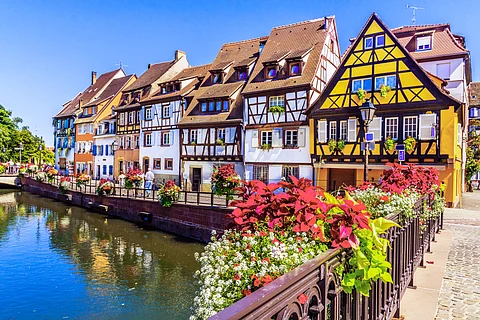

ISTOCK
Imagine opening a picture book where every page shows a different world — one filled with half-timbered houses draped in flower boxes, cobbled lanes winding past medieval churches, and rolling vineyards stretched beneath snow-dusted mountains. There are villages so colourful they seem painted by a child, and cafes where the aroma of buttery pastries mingles with the scent of spicy sausages. It all feels like a fairy tale — but this is not a made-up place. It's a real region in eastern France called Alsace.
Tucked between the Vosges Mountains and the River Rhine, Alsace has been shaped by centuries of French and German influence. Its location on the border has made it a place of both blending and belonging — a region that feels like two worlds in one. This unique identity makes Alsace one of the most fascinating and culturally rich places in Europe.
Wander through towns like Colmar and Strasbourg, and you’ll feel as if you’ve stepped back in time. In Colmar, narrow canals glide through rows of pastel houses with steep roofs and carved wooden beams. Locals call it “Little Venice,” and you’ll see why. Strasbourg, on the other hand, is a bustling city with a grand Gothic cathedral whose spire once made it the tallest building in the world. If you visit during Christmas, the entire city glows with fairy lights, as Strasbourg hosts one of Europe’s oldest and most magical Christmas markets.
But Alsace isn’t just beautiful — it’s also deeply historic. Over the centuries, it has changed hands many times between France and Germany. This tug-of-war has left its mark not only on the buildings and language but also in the hearts of its people. In many Alsatian homes, you’ll still hear both French and Alsatian — a Germanic dialect — spoken at the dinner table. Street signs often display names in both languages, and schoolchildren grow up learning to celebrate both cultures.
Food in Alsace is a perfect example of this delicious mix. You might start your day with a buttery croissant and end it with choucroute garnie — a hearty dish of sauerkraut, sausages, and salted meats. Flammekueche, or tarte flambée, is a local favourite that looks like a thin pizza topped with cream, onions, and bacon. And if you have a sweet tooth, don’t miss kugelhopf, a yeasty cake often dotted with raisins and almonds. Many families have their own secret recipe passed down through generations.
The region is also famous for its wines — especially white wines like Riesling and Gewürztraminer. The Alsace Wine Route is one of the oldest in France, taking visitors through scenic hills, vineyard-covered slopes, and charming cellar doors where winemakers still use wooden barrels and family traditions.
Nature lovers will find plenty to explore too. The Vosges Mountains are full of forest trails, ancient castles, and stunning views across the Rhine Valley. In spring and summer, the meadows bloom with wildflowers, and in autumn, the vineyards turn golden and red. Alsace is one of the greenest regions in France, and many villages have won awards for their eco-friendly living.
History also lives in the region’s castles and forts. The Château du Haut-Koenigsbourg stands proudly on a hill, watching over the valley like a knight from the past. First built in the 12th century, it has been destroyed and rebuilt several times — a symbol of Alsace’s resilience. Other forts and ruins scattered through the hills whisper stories of battles, kings, and shifting borders.
Yet, despite its past, Alsace is a region that looks forward. In recent years, it has become known for its commitment to sustainability, education, and innovation. Bicycles are more common than cars in some towns, and schools often include nature-based learning and local culture in their curriculum. Alsace encourages children not just to remember the past but to imagine the future.
So what makes Alsace truly special? It’s not just the scenery, the food, or the fairy-tale towns. It’s the way everything fits together — how French elegance and German warmth meet in one place.
ISTOCK
The Strasbourg Cathedral has an astronomical clock that doesn’t just tell time — it shows the position of planets, moon phases, and even has moving mechanical figures that perform every day at 12:30 pm.
ISTOCK
The enchanting village of Eguisheim, with its circular layout and brightly coloured houses, is said to have inspired the look of Belle’s hometown in Disney’s 'Beauty and the Beast.'
ISTOCK
Haut-Koenigsbourg Castle was restored by Kaiser Wilhelm II in the 1900s when Alsace was under German control. He filled it with medieval-style decor to show off Germany’s might.
ISTOCK
In Gertwiller, Alsace has a gingerbread museum (Musée du Pain d'Épices) where you can learn how this spicy-sweet treat was baked in the region for centuries.
In medieval times, houses in Alsace didn’t have numbers — instead, they had animal names or signs painted or carved on them, like House of the Cat or House of the Rooster.
Alsace has a traditional red-and-white flag that many locals still display with pride. It’s not France’s national flag, but a regional symbol of their mixed heritage.
Some Alsatian towns are just a bridge away from Germany — literally! Cross a river like the Rhine and you’ll be in another country, no passport check needed.
In towns like Riquewihr, look closely at the timber-framed houses — some have tilted or leaning walls, built that way centuries ago to fit into narrow medieval streets.
Many streets in Alsace display their names in both French and Alsatian — a reminder of the region’s mixed cultural roots.